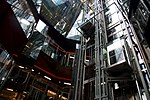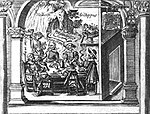St Peter, Westcheap, also called "St Peter Cheap", "St Peter at the Cross in Cheap", or "Ecclesia S. Petri de Wodestreet", was a parish and parish church of medieval origins in the City of London. The church stood at the south-west corner of Wood Street where it opens onto Cheapside, directly facing the old Cheapside Cross. In its heyday it was a familiar landmark where the City waits used to stand on the roof and play as the great processions went past. It was destroyed in the Great Fire of London in 1666, together with most of its surroundings, and was never rebuilt.
In its place three shops were built on the Cheapside frontage in 1687, and the land behind continued to be used as a burial-ground and garden, which was enclosed with railings in 1712. The ancient Cheapside plane tree grows there, and with the group of houses and garden survived the Second Great Fire of London in December 1940. The garden is still maintained for public use. Here William Wordsworth was moved to write of "Poor Susan" who, hearing the song of a thrush in the busy London thoroughfare, was transported by the vision of a stream flowing through the fields and her solitary cottage in the countryside.
The small parish of St Peter Westcheap lay on the north of Cheapside, between the lower ends of Gutter Lane in the west and Wood Street in the east, and enclosed the whole of Goldsmith Street. It was mainly in the Ward of Farringdon Within, but also touched on Bread Street Ward and Cripplegate Ward. After the Fire it was united with St Matthew Friday Street (to the south of Cheapside). That church was demolished in 1885 and the parishes were united with St Vedast Foster Lane.











